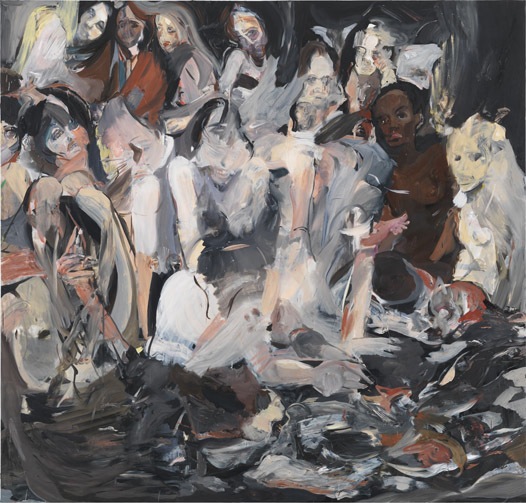Cecily Brown Shows Her Women Uptown
For her most recent exhibition at Gagosian Gallery, Cecily Brown focused on art’s most enduring subject: the female nude. Groups of them cluster on six canvases, their shapes drawn from gray gradients and bold highlights, and articulated in wispy strokes and amorphous planes.
Echoes of other artists, styles, or, as one man said to Brown, “ourselves,” are all valid observations: “I’ve really let a lot of influence come out recently,” says Brown, listing German Expressionism, Francis Bacon, James Ensor, and Edvard Munch as examples. “They’re not appropriated,” she adds. “They just have ancestors in different art historical places.” Working with so many faces, she felt freed from a single genre. “One face might be more photographic, one might be from Munch, one from Ensor. My husband said one looks just like the Virgin Mary.”
An iconic image of contemporary origin was her starting point: “It’s the cover of Jimi Hendrix’s [1968 album] Electric Ladyland,” she discloses. It became her working motif, informing, but not dictating, the crowds of women. “Formally, I was drawn to it,” she explains, citing the arrangement of the women—”like a pile of body parts.”
Fixating on the composition, Brown experimented with fragmenting the figures and rebuilding them. “It becomes its own painterly world, and the women come and go,” she describes. Situated in an indefinite space, “it feels more psychological, or from something in your memory.” Brown’s women appear more ghostlike than Hendrix girl–”I certainly didn’t want to paint a room full of groupies.”
But she too is waiting to learn their meaning. “I’m not the kind of artist who has an idea and then carries it out; it’s more like I find what the idea was through doing the paintings,” she says. “I’ll probably have all sorts of brilliant thoughts when I actually spend time looking at them.”
CECILY BROWN’S PAINTINGS ARE ON DISPLAY AT THE GAGOSIAN GALLERY IN NEW YORK, 980 MADISON AVENUE, THROUGH JUNE 22.







